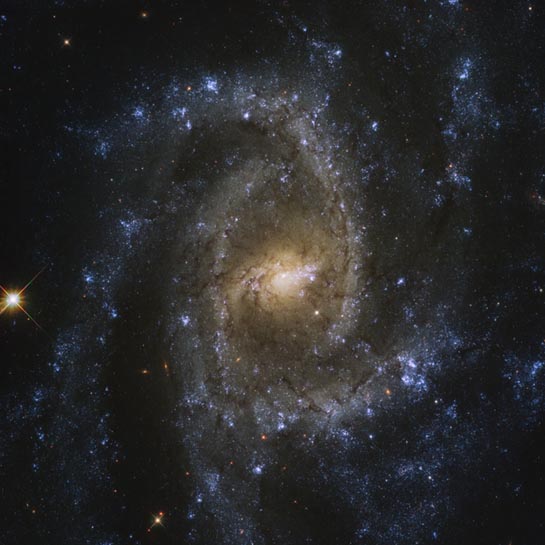
Spiral galaxy
RA 9h 17m 53.09s Dec -22° 21' 16.14"
Hydra
35 million light-years
10.3
6.6 x 4.4 arcmin
2.68 x 2.60 arcminutes
North is 4.5° right of vertical
ESA/Hubble & NASA, J. Lee, and the PHANGS-HST Team
September 14, 2020
ABOUT
THIS IMAGE:
The twisting patterns created by the multiple spiral arms of NGC 2835 create the illusion of an eye. This is a fitting description, as this magnificent galaxy resides near the head of the southern constellation of Hydra, the water snake. This stunning barred spiral galaxy, with a width of just over half that of the Milky Way, is brilliantly featured in this image taken by the NASA/ESA Hubble Space Telescope. Although it cannot be seen in this image, a supermassive black hole with a mass millions of times that of our Sun is known to nestle in the very centre of NGC 2835 .
This galaxy was imaged as part of PHANGS-HST, a large galaxy survey with Hubble that aims to study the connections between cold gas and young stars in a variety of galaxies in the local Universe. Within NGC 2835, this cold, dense gas produces large numbers of young stars within large star formation regions. The bright blue areas, commonly observed in the outer spiral arms of many galaxies, show where near-ultraviolet light is being emitted more strongly, indicating recent or ongoing star formation.
Expected to image over 100,000 gas clouds and star-forming regions outside our Milky Way, this survey hopes to uncover and clarify many of the links between cold gas clouds, star formation and the overall shape and morphology of galaxies. This initiative is a collaboration with the international Atacama Large Millimeter/submillimeter Array (ALMA) and the European Southern Observatory's Very Large Telescope's MUSE instrument, through the greater PHANGS program (PI: E. Schinnerer.)
From Wikipedia:
NGC 2835 is an intermediate spiral galaxy located in the constellation Hydra. It is located at a distance of circa 35 million light years from Earth, which, given its apparent dimensions, means that NGC 2835 is about 65,000 light years across. It was discovered by Wilhelm Tempel on April 13, 1884. NGC 2835 is located only 18.5 degrees from the galactic plane.
NGC 2835 is seen nearly face-on. The galaxy features four or five spiral arms, visible in near infrared due to their population II stars. The spiral arms have also numerous HII regions and stellar associations, the larger of which are 5 arcseconds across. Although the galaxy is quite symmetric, the northern arms have HII regions that appear brighter than the southern ones. Also the southern arms appear less developed in their outer parts than the north ones. The star formation rate in NGC 2835 is 0.4 M☉ per year and the total stellar mass of the galaxy is low, at 7.6x109 M☉. In the center of NGC 2835 lies a supermassive black hole whose mass is estimated to be 3-10 million (106.72±0.3) M☉, based on the spiral arm pitch angle.
NGC
2835 is the foremost galaxy in a small group of galaxies, the NGC 2835
group. Other galaxies identified as members of the cluster are ESO 497-035,
and ESO 565-001. A bit further away, at projected separation of 2.2 degrees,
lies NGC 2784 and its small galaxy group.
NOTE:
M☉ is astronomical
shorthand for solar mass(es)